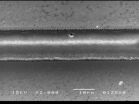(Press-News.org) An Ohio State University molecular biologist leveraged a supercomputer to help better define the family tree of a group of enzymes that have been implicated in a wide range of human diseases and are important targets for anti-cancer therapies.
Along with several OSU colleagues, Rebecca S. Lamb, Ph.D., an assistant professor of Molecular Genetics, recently analyzed the evolutionary history of the poly(ADP-ribose)polymerase (PARP) superfamily.
These proteins are found in eukaryotes, a wide range of organisms – animals, plants, molds, fungi, algae and protozoa –whose cells contain complex structures enclosed within membranes. While PARP proteins can be found with any of these "supergroups," they have been most extensively studied in mammals.
"In these organisms, PARPs have key functions in DNA repair, genome integrity and epigenetic regulation," said Lamb. "More recently it has been found that proteins within the PARP superfamily have a broader range of functions that initially predicted."
The researchers used computers to identify 236 PARP proteins from 77 species across five of the six supergroups. Lamb then accessed the Glen Cluster at the Ohio Supercomputer Center (OSC) to perform extensive phylogenetic analyses of the identified PARP regions.
"This is computationally intensive work that would have been impossible without the computer resources provided at OSC," Lamb said. "In particular, the ability to try a variety of tools that require a great deal of CPU and memory capabilities was essential for success."
Amongst other tools, she employed the PhyML3.0 software package, which fit a statistical model to the aligned sequence data and provided estimates for the model's parameters.
"Dr. Lamb's project is an excellent example of a scientist running a very domain-specific software package on our state-of-the-art systems," said Ashok Krishnamurthy, Ph.D., interim co-executive director of OSC. "While the center maintains a large collection of licensed and open-source software, there are occasions where very specialized or customized applications are required. Our staff members are very good at working with researchers to modify these codes to get them installed, running and delivering results."
Access to powerful OSC systems allowed the researchers to experiment with a wide variety of options and parameters, in order to achieve the best results, Lamb noted.
"PARPs are found in all eukaryotic supergroups for which sequence is available, but some individual lineages within supergroups have independently lost these genes," said Lamb. "The PARP superfamily can be subdivided into six branches or 'clades.' Two of these clades were likely found in the last common eukaryotic ancestor. In addition, we have identified PARPs in organisms in which they have not previously been described."
Three main conclusions were drawn from the study. First, the broad distribution and pattern of representation of PARP genes indicated to the researchers that the ancestor of all existing eukaryotes encoded proteins of this type. Second, the ancestral PARP proteins had different functions and activities. One of these proteins likely functioned in DNA damage response. Third, the diversity of the PARP superfamily is larger than previously documented, suggesting as more eukaryotic genomes become available, this gene family will grow in both number and type.
INFORMATION:
The study, "Evolutionary history of the poly(ADP-ribose) polymerase gene family in eukaryotes," was authored by Lamb and OSU colleagues Matteo Citarelli and Sachin Teotia and appeared in a recent issue of the journal BMC Evolutionary Biology. The work was supported by a grant from the Ohio Plant Biotechnology Consortium and by funds from the Ohio State University.
Study analyzes role of PARP enzyme in eukaryotes
OSU's Lamb leverages supercomputer to study protein's evolution
2011-03-09
ELSE PRESS RELEASES FROM THIS DATE:
As we sleep, speedy brain waves boost our ability to learn
2011-03-09
Scientists have long puzzled over the many hours we spend in light, dreamless slumber. But a new study from the University of California, Berkeley, suggests we're busy recharging our brain's learning capacity during this traditionally undervalued phase of sleep, which can take up half the night.
UC Berkeley researchers have found compelling evidence that bursts of brain waves known as "sleep spindles" may be networking between key regions of the brain to clear a path to learning. These electrical impulses help to shift fact-based memories from the brain's hippocampus ...
How long does a tuning fork ring?
2011-03-09
This release is available in German.
From the wooden bars in a xylophone or the head of a drum, to the strings and sound box of a guitar or violin, musical instruments are the most familiar examples of mechanical resonators. The actual mechanical vibrations of these instruments create acoustic waves that we hear as sound. The purity of the emitted tone is intimately related to the decay of the vibration amplitude, that is, the mechanical losses of the system. A figure of merit for mechanical losses is the quality factor, simply called "Q", which describes the number ...
First census finds surprisingly few white sharks off California
2011-03-09
In the first census of its kind, research led by UC Davis and Stanford University found that there are far fewer white sharks off central California than biologists had thought.
The study, published today in the journal Biology Letters, is the first rigorous scientific estimate of white shark numbers in the northeast Pacific Ocean. It is also the best estimate among the world's three known white-shark populations (the others are in Australia/New Zealand and South Africa).
The researchers went out into the Pacific Ocean in small boats to places where white sharks congregate. ...
Cleansing the soul by hurting the flesh: The guilt-reducing effect of pain
2011-03-09
Lent in the Christian tradition is a time of sacrifice and penance. It also is a period of purification and enlightenment. Pain purifies. It atones for sin and cleanses the soul. Or at least that's the idea. Theological questions aside, can self-inflicted pain really alleviate the guilt associated with immoral acts? A new study published in Psychological Science, a journal of the Association for Psychological Science, explores the psychological consequences of experiencing bodily pain.
Psychological scientist Brock Bastian of the University of Queensland, Australia and ...
March GSA Today: The case for a neoproterozoic oxygenation event
2011-03-09
The Cambrian "explosion" of multicellular animal life is one of the most significant evolutionary events in Earth's history. But what was it that jolted the Earth system enough to prompt the evolution of animals? While we take the presence of oxygen in our atmosphere for granted, it was not always this way.
The Neoproterozoic era that preceded the Cambrian explosion of life was witness to a dramatic rise in oxygen levels. It has been widely assumed that the rise in atmospheric oxygen was the essential precursor to the evolution of animals. But the work of Graham Shields-Zhou ...
UNC study finds oral tongue cancer increasing in young, white females
2011-03-09
Chapel Hill, NC – A UNC study released this week in the Journal of Clinical Oncology finds an increasing incidence of squamous cell carcinoma of the oral tongue in young white females in the United States over the last three decades.
A team of researchers from UNC Lineberger Comprehensive Cancer Center analyzed data from the National Cancer Institute's Surveillance, Epidemiology and End Results (SEER) database and found that, between 1975 and 2007, the overall incidence for all ages, genders, and races of the disease was decreasing. However, the incidence of oral tongue ...
Real March Madness is relying on seedings to determine Final 4
2011-03-09
CHAMPAIGN, Ill. — Think picking all the top-seeded teams as the Final Four in your March Madness bracket is your best bet for winning the office pool? Think again.
According to an operations research analysis model developed by Sheldon H. Jacobson, a professor of computer science and the director of the simulation and optimization laboratory at the University of Illinois, you're better off picking a combination of two top-seeded teams, a No. 2 seed and a No. 3 seed.
"There are patterns that exist in the seeds," Jacobson says. "As much as we like to believe otherwise, ...
It's all in a name: 'Global warming' vs. 'climate change'
2011-03-09
ANN ARBOR, Mich.---Many Americans are skeptical about whether the world's weather is changing, but apparently the degree of skepticism varies systematically depending on what that change is called.
According to a University of Michigan study published in the forthcoming issue of Public Opinion Quarterly, more people believe in "climate change" than in "global warming."
"Wording matters," said Jonathon Schuldt, the lead author of the article about the study and a doctoral candidate in the U-M Department of Psychology.
Schuldt co-authored the study with U-M psychologists ...
Ultrafast laser 'scribing' technique to cut cost, hike efficiency of solar cells
2011-03-09
WEST LAFAYETTE, Ind. - Researchers are developing a technology that aims to help make solar cells more affordable and efficient by using a new manufacturing method that employs an ultrafast pulsing laser.
The innovation may help to overcome two major obstacles that hinder widespread adoption of solar cells: the need to reduce manufacturing costs and increase the efficiency of converting sunlight into an electric current, said Yung Shin, a professor of mechanical engineering and director of Purdue University's Center for Laser-Based Manufacturing.
Critical to both are ...
Oldest known wild bird in US returns to Midway to raise chick
2011-03-09
MIDWAY ATOLL — The oldest known U.S. wild bird – a coyly conservative 60 -- is a new mother.
The bird, a Laysan albatross named Wisdom, was spotted a few weeks ago with a chick by John Klavitter, a U.S. Fish and Wildlife Service biologist and the deputy manager of the Midway Atoll National Wildlife Refuge.
The bird has sported and worn out 5 bird bands since she was first banded by U.S. Geological Survey scientist Chandler Robbins in 1956 as she incubated an egg. Chandler rediscovered Wisdom in 2001. In 1956, he estimated Wisdom to be at least 5 years old then since ...
LAST 30 PRESS RELEASES:
UVA’s Jundong Li wins ICDM’S 2025 Tao Li Award for data mining, machine learning
UVA’s low-power, high-performance computer power player Mircea Stan earns National Academy of Inventors fellowship
Not playing by the rules: USU researcher explores filamentous algae dynamics in rivers
Do our body clocks influence our risk of dementia?
Anthropologists offer new evidence of bipedalism in long-debated fossil discovery
Safer receipt paper from wood
Dosage-sensitive genes suggest no whole-genome duplications in ancestral angiosperm
First ancient human herpesvirus genomes document their deep history with humans
Why Some Bacteria Survive Antibiotics and How to Stop Them - New study reveals that bacteria can survive antibiotic treatment through two fundamentally different “shutdown modes”
UCLA study links scar healing to dangerous placenta condition
CHANGE-seq-BE finds off-target changes in the genome from base editors
The Journal of Nuclear Medicine Ahead-of-Print Tip Sheet: January 2, 2026
Delayed or absent first dose of measles, mumps, and rubella vaccination
Trends in US preterm birth rates by household income and race and ethnicity
Study identifies potential biomarker linked to progression and brain inflammation in multiple sclerosis
Many mothers in Norway do not show up for postnatal check-ups
Researchers want to find out why quick clay is so unstable
Superradiant spins show teamwork at the quantum scale
Cleveland Clinic Research links tumor bacteria to immunotherapy resistance in head and neck cancer
First Editorial of 2026: Resisting AI slop
Joint ground- and space-based observations reveal Saturn-mass rogue planet
Inheritable genetic variant offers protection against blood cancer risk and progression
Pigs settled Pacific islands alongside early human voyagers
A Coral reef’s daily pulse reshapes microbes in surrounding waters
EAST Tokamak experiments exceed plasma density limit, offering new approach to fusion ignition
Groundbreaking discovery reveals Africa’s oldest cremation pyre and complex ritual practices
First breathing ‘lung-on-chip’ developed using genetically identical cells
How people moved pigs across the Pacific
Interaction of climate change and human activity and its impact on plant diversity in Qinghai-Tibet plateau
From addressing uncertainty to national strategy: an interpretation of Professor Lim Siong Guan’s views
[Press-News.org] Study analyzes role of PARP enzyme in eukaryotesOSU's Lamb leverages supercomputer to study protein's evolution



